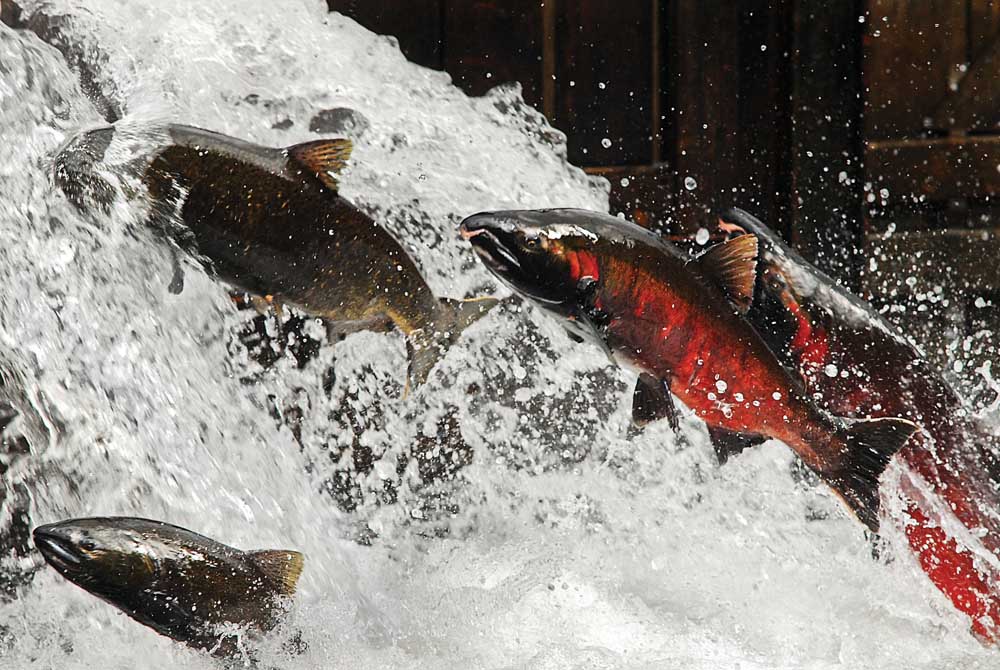Willapa Bay gillnetters lock horns with state
Published 3:57 am Wednesday, December 16, 2015

- Salmon return to the Nemah Hatchery on Willapa Bay in 2015.
WILLAPA BAY, Wash. — Drought hit Willapa Bay salmon runs hard this year while questions remain about how a new commercial salmon fishing policy affects local fishermen.
At a recent meeting at Naselle High School, representatives from the Washington Department of Fish and Wildlife expected to field questions regarding the die-off of approximately 10,000 salmon below the Naselle Hatchery due to low stream flow and other drought-related factors this fall.
Instead, they spent most of the time hearing concerns from commercial gillnet fishermen living on both sides of the Columbia River regarding the salmon fishing policy that went into effect earlier this year.
The concerns were pretty much the same as what both fishermen and seafood processors stated before the policy went into effect, according to Steve Thiesfeld, regional fish program manager for the Department of Fish and Wildlife. But he believes the policy is sound.
“I think the fishing season in and of itself and how it transpired will help us craft seasons into next year,” he said in an interview, adding many of the fishermen present seemed to want to judge the merits of the policy solely on the most recent season — a season he said was complicated by drought conditions and a much lower than expected return of coho salmon.
“I think folks need to be careful not to judge on one year’s performance,” he said.
Fishermen earlier this year called the new policy a “nail in the coffin,” anticipating that it would soon make little economic sense for them to continue fishing Willapa Bay under the policy, which is supposed to become more restrictive in coming years.
Of the 27 commercial fishing days scheduled on Willapa Bay’s river systems this fall, gillnetters ended up only fishing 10. Landings of Chinook salmon were also higher than anticipated, contributing to this reduction of fishing days.
Under the new policy, fishermen were given a 20 percent harvest rate on natural origin Chinook — salmon that have not had their adipose fins clipped by hatchery employees and could be wild fish or the descendants of former hatchery fish that have “strayed” and no longer return to the hatchery, according to state fishery managers.
Once this percentage is neared, fishery managers typically re-evaluate how and when gillnetters fish, often shifting the focus of the fishery to another salmon species.
On Willapa Bay, and especially under the new policy, the focus would normally shift to coho, but the problem was that this year coho came back at only 42 percent of what was forecast. And, with the already high impacts to natural-origin Chinook, fishery managers did not want to risk further accidental catch of Chinook by shifting fishermen to another species. So commercial gillnetting closed in November in the Willapa Bay area. Fishery managers also closed the marine recreational fishery and restricted a freshwater fishery to hatchery streams.
According to preliminary data released by the state, gillnetters caught a season total of 4,858 Chinook, 1,935 coho and 2,803 chum in the Willapa Bay Non-Indian Commercial Gillnet Salmon Fishery from Sept. 6 through Oct. 10.
Willapa Bay Gillnetters Association President Bob Lake fished only a handful of days this season, with poor results. He believes the policy is wrong, both in its scope and for the area.
The new policy’s stated goals are to reduce impacts to natural-origin Chinook and shift commercial fishery impacts to coho while minimizing chum mortalities. In future years, this will also mean further reducing the percentage of natural-origin Chinook gillnetters can catch while also reducing the number of fish produced by the Naselle Hatchery.
While the policy was out for public comment this spring, Department of Fish and Wildlife Commissioner Miranda Wecker and other state fishery managers said these steps were critical to rebuild wild runs of salmon in Willapa Bay. But fishermen and processors protested, saying the salmon fishing in the bay is dependent on high hatchery production and that no true wild runs exist.
Lake recalls past efforts to restore wild runs in these systems — and how they failed.
“We’re at the mercy of people who don’t know anything about Willapa Bay,” he said.
A lawsuit filed against the Department of Fish and Wildlife by the gillnetters association claiming the policy is misguided and adversely affects fishermen is still moving forward after being refiled in Thurston County.
Meanwhile, state fishery managers are hopeful for next year’s seasons on Willapa Bay.
In an average year they expect to see around 1,000 — maybe less — dead fish below the Naselle Hatchery. The number of fish noticed by passers-by led to the department doing a detailed count to try to record the scope of the die-off. Elsewhere, in southern Oregon and eastern Washington, hatcheries experienced massive die-offs, well beyond the fall run die-offs recorded near the Naselle Hatchery.
This year’s count of 10,000 was highly unusual, indicative of unusual conditions, Thiesfeld said. It does not significantly change how coastal hatcheries will operate in coming years, he said.
“Ideally,” he added, “we won’t be looking at a record drought next year.”




